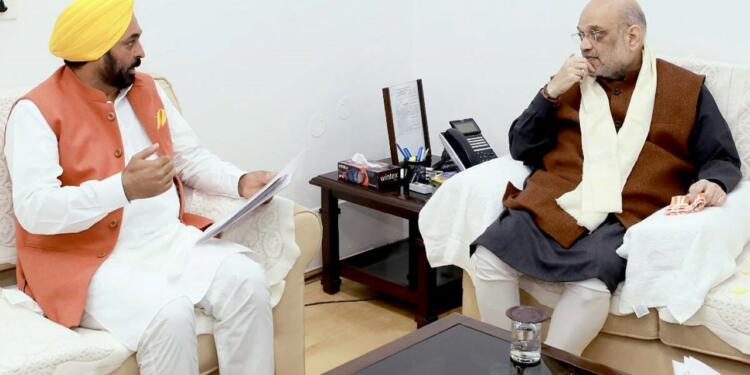Overnight, Punjab has gotten the attention of the whole country. And how did they manage that? Well, in an unanticipated hunt, the Punjab Police along with the Central Forces are hitting the corners of the state. In between all this, there are lots of speculations about Bhagwant Maan, the Chief Minister of Punjab. Lately, he seems to be alienating his ally Arvind Kejriwal and his style of politics.
So, let us understand from the very beginning how Punjab and Bhagwant Maan decided to take on the most radical element in the state. But before that, you need to take a brief look at how Arvind Kejriwal compromised national security by influencing politics.
Arvind Kejriwal’s hopeless politics
Arvind Kejriwal rose to power in Delhi through the anti-corruption movement led by Anna Hazare. However, he soon showed his political aspirations through his decision to form a political party, the Aam Aadmi Party (AAP), and participate in electoral politics, betraying the movement’s ideals.
Ironically, AAP formed a government with the support of the same Congress party against which they fought the anti-corruption battle. The vested interest in gaining power depicted how low they can go. But it did not end here. After analyzing the electoral threat from the BJP, they shifted the goalposts from Congress to the BJP. Eventually, Arvind Kejriwal formed the government with an absolute majority, but soon the so-called democratic warrior turned his party into an oligarchic one.
Their own party leaders, Yogendra Yadav and Prashant Bhushan, accused Kejriwal of running the party in an undemocratic manner and failing to uphold transparency and accountability. Kejriwal showed his true colors when he expelled them from the party in 2015.
Also read: Gangs of LiquorPur: Sardar Kejriwal and Ramadhir KCR are friends in this new epic saga
Kejriwal’s style of politics
In addition to the criticisms leveled against Arvind Kejriwal, various other prominent leaders also left the party, citing concerns over its functioning. Kumar Vishwas, a founding member, accused Kejriwal of betraying the values of the anti-corruption movement and running the party in an autocratic manner. Kiren Bedi, a former IPS, who had joined the AAP, also left over differences with Kejriwal’s leadership style.
The Kejriwal style of politics is to restrict the inner circle for other leaders and take decisions in an autocratic way. Anyone who just took the initiative against the Supreme Leader was destined to be either thrown out or degraded to the point that they left the party themselves.
Burst of anti-corruption myth
Arvind Kejriwal and his brigade of Manish Sisodia and Satyendra Jain did not have any emphasis on party democracy. The party leaders were just busy with corruption, which soon came to light in the public domain when Satyendra Jain, who served as the Health Minister in the Delhi government, was found involved in corruption in relation to the procurement of medical equipment.
On similar grounds, the liquor policy unveiled the reality of Manish Sisodia. The question was raised as to why Sisodia had more than 17 ministries under him. And how is it possible that Kejriwal did not know about it? There were speculations that Kejriwal too had taken a share.
In the Kejriwal style of politics, Delhi’s peculiar federal status proved to be a leveraging point. In almost nine years of his government in Delhi, Kejriwal has never tried to normalize constitutional relations with the Lieutenant Governor of Delhi. Instead, every time a new LG was appointed, Kejriwal and his party started to blame the LG for everything and shed their responsibilities. The populist and appeasing policies sustained his government, but the governance was compromised by the most pathetic model.
Also read: The noose of Moose is around Mann’s neck
National aspiration
But he was not satisfied with Delhi alone. This was evident from his political campaign against PM Modi in Varanasi during the 2014 general elections, for which he was ready to compromise the faith of Delhi’s people. Fortunate for the country, he failed severely. He did, however, seek another path by acquiring power in the individual state. After consolidating power in Delhi, his aspirations grew further, and the party fought elections in other states too. Interestingly, AAP got more seats than anticipated in states and even formed the government in Punjab under Bhagwant Maan.
Sisodia de-facto
But things started to change in a swift way. While Kejriwal was busy targeting PM Modi and campaigning for state elections, Sisodia established himself as the de-facto CM of Delhi. He held every portfolio of the government that was not allotted to anyone. Generally, CM holds this special status. Sisodia’s resignation has prompted speculation that he has met the same fate as the former leaders of the party. This was evident by the resignations of Sisodia and Satyendra Jain, which were accepted at once.
Previously, Satyendra Jain was also jailed but never resigned. This will certainly help in growing Raghav Chaddha’s position in the party; sources at one point claimed him to be a future relative (my guess would be son – in – law) of Arvind Kejriwal.
Also read: Has Arvind Kejriwal ‘ditched’ Manish Sisodia?
Punjab suffered
Now coming to the other state that is ruled by AAP, i.e., Punjab. After a lot of political chaos, Punjab witnessed a shift when it chose AAP. Bhagwant Maan became the CM. Apparently, the worst phase of Punjab started with the revival of Khalistani elements in society in the form of “Waris Punjab De”. Maan’s government miserably failed the people’s cause and threw the state into violence. He proved so incompetent that in the vicinity of his official residence a bomb was found, and still he kept his hands folded.
His blind governance empowered radicalized terrorist elements that are now challenging state power. In reality, he was following Arvind Kejriwal’s politics, which revolve around shedding the burden of responsibilities on LG’s shoulders. But the situations in Punjab were not the same. Punjab is not a quasi-state like Delhi, and being a border state, it needs to be ruled according to the needs of the state, not the party. Along with that, Kejriwal’s dictatorial behavior was also a big challenge for Maan. His inaction in the Amritpal Singh case furious the central government. But it looks like, after meeting with Amit Shah Maan, he has chosen the right way forward.
Shah takes charge now
On March 2, Bhagwant Maan visited Delhi, where he met Amit Shah and discussed the law and order situation in Punjab. Reports claim that it was decided to take action on Amritpal Singh as the intelligence community reported his links with ISI and the whole module that helped him from across countries like the UK and Canada.
Probably, Maan has no option, as Amritpal’s ISI connections were proven, and resisting the government could have led to repercussions. So, either Maan must collaborate with the Centre or the Centre will take over. The actions, however, were not to be taken immediately because the G20 meeting of Central Bank Deputies was scheduled for Friday.
So it was decided by the central government to hunt him by sending central forces to assist the Punjab Police after the meeting. And now the police are hitting them, and hitting them hard. Currently, Amritpal is on the run, but Waris Punjab De and related elements are claiming that police have already caught him. Well! It is yet to be seen what happens next.
Support TFI:
Support us to strengthen the ‘Right’ ideology of cultural nationalism by purchasing the best quality garments from TFI-STORE.COM






























